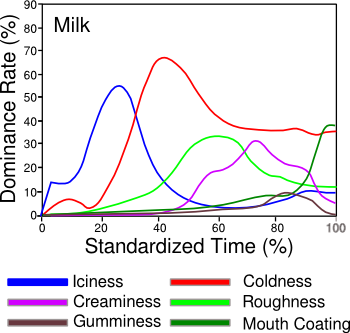Engineering Ice Cream
June 18, 2014
Materials science is the study of how the
properties of materials are determined by their
composition and
structure.
diamond and
graphite are both pure
carbon, but the properties of these are different because of the arrangement of the carbon
atoms. In
cooking, the same
ingredients can yield different results depending on how they're processed.
Packaged
cookies were always
brittle bits of
baked batter until
Proctor & Gamble introduced a soft cookie, "crispy on the outside and chewy on the inside," through its
Duncan Hines brand in 1983. This type of cookie was
innovative, and the other major cookie manufacturers,
Nabisco,
Keebler, and
Frito-Lay followed with their own versions. Proctor & Gamble's cookie was
patented,[1] so it filed a
patent infringement lawsuit against the other companies in 1989.[2]
As can be imagined, patenting a food
recipe and winning an infringement claim are hard to do. In short, as the
cookbook section of your local
bookshop, if it still exists, will prove, there's a lot of
prior art. One piece of prior art for this cookie was a recipe for "Rigglevake Kucha" (
Railroad Cookies) in a 1968 book authored by
Edna Staebler of
Kitchener, Ontario, Canada. Staebler had received the recipe from a friend, Bevvy Martin.[2] This recipe was cited by the
inventors in their
patent application.[1]
A recipe is one thing, but the process for making the cookies is another, and Staebler had never baked them herself. Nevertheless, there were requests from
lawyers from both sides for samples of the ingredients and samples of the cookies, which were baked in large quantities by Staebler's friends.[2] As it turned out, the crispy-chewy cookie
market wasn't that large, and the three supposed infringers paid a $125 million
pre-trial settlement to Proctor and Gamble, agreeing that the patent was
legal and enforceable.[2]

My favorite chewy cookie, the coconut macaroon.
(Photo by Jessica Spengler, via Wikimedia Commons.)
A hundred and twenty-five million dollars in 1989 money (nearly a quarter of a million dollars in
today's money) should convince you that there's
high technology in the
food industry; and, where there's high technology, there's also
science.
Scientists at the
Institute of Agrochemistry and Food Technology (Valencia, Spain) have just
published a study of the
temporal evolution of perceived
qualities during consumption of various types of
ice cream.
Unlike
experiments in the
physical sciences, where
numbers rule your experiment, experiments involving perceptions experienced while
eating are a little more complicated. In such studies,
statistics rule, so the number of study participants needs to be large. There were 85 in this study, and they all got to eat six different compositions of
vanilla ice cream made with varied amounts of
milk,
cream,
egg, and
hydrocolloids,
macromolecules that enhance thickness and
stability.[3]
The study participants pointed out on a screen the most dominant quality of the ice cream present at each moment of eating, from the first taste to just after
swallowing. The qualities assessed were
iciness,
coldness,
creaminess,
roughness,
gumminess, and
mouth coating.[3] The resulting flow of qualities with time is known as "Temporal Dominance of Sensations" (TDS). A statistical analysis allows a
graphical display of which sensation dominates at any moment (see graph).[4]

Temporal Dominance of Sensations (TDS) curves for ice cream containing only sweetened milk.
(IATA image, redrawn for clarity.)
As shown in the
graph, above, ice cream made only with milk and
sugar has coldness and roughness, two things found undesirable by
consumers.[4] The initial cold/icy sensation is reduced by addition of hydrocolloids, which also enhance creaminess, a quality consumers associate with high quality ice cream (see graph, below).[4] Such TDS methods can help
manufacturers of other food items
engineer their
products for perceived better quality.[4]

Temporal Dominance of Sensations (TDS) curves for ice cream containing milk, cream, egg and hydrocolloids.
(IATA image, redrawn for clarity.)
![]()
References:
- Janelle Martin, "Edna Staebler and the Great Cookie War," The Mennonite Heritage Portrait Web Site.
- Charles A. Hong and William J. Brabbs, "Doughs and cookies providing storage-stable texture variability," US Patent No. 4,455,333, June 19, 1984.
- Paula Varela, Aurora Pintor and Susana Fiszman, "How hydrocolloids affect the temporal oral perception of ice cream," Food Hydrocolloids, vol. 36 (May 2014), pp. 220-228.
- Ice cream sensations on the computer, Spanish Foundation for Science and Technology Press Release, June 4, 2014.
Permanent Link to this article
Linked Keywords: Materials science; properties of materials; composition; structure; diamond; graphite; carbon; atom; cooking; ingredient; cookie; brittle; baked; batter; Proctor & Gamble; Duncan Hines; innovation; innovative; Nabisco; Keebler Company; Frito-Lay; patent; patented; patent infringement; lawsuit; recipe; cookbook; bookshop; prior art; railroad; Edna Staebler; Kitchener, Ontario, Canada; invention; inventor; patent application; lawyer; market; pre-trial; settlement; law; legal; coconut macaroon; Jessica Spengler; Wikimedia Commons; time value of money; today's money; high tech; high technology; food industry; science; scientist; Institute of Agrochemistry and Food Technology (Valencia, Spain); scientific literature; publish; time; temporal; quality; ice cream; experiment; physical sciences; number; eating; statistics; vanilla; milk; cream; egg; hydrocolloid; macromolecule; stability; swallowing; iciness; coldness; creaminess; roughness; gumminess; mouth; graphics; graphical; graph; sugar; consumer; manufacturer; engineer; product; Charles A. Hong and William J. Brabbs, "Doughs and cookies providing storage-stable texture variability," US Patent No. 4,455,333, June 19, 1984.